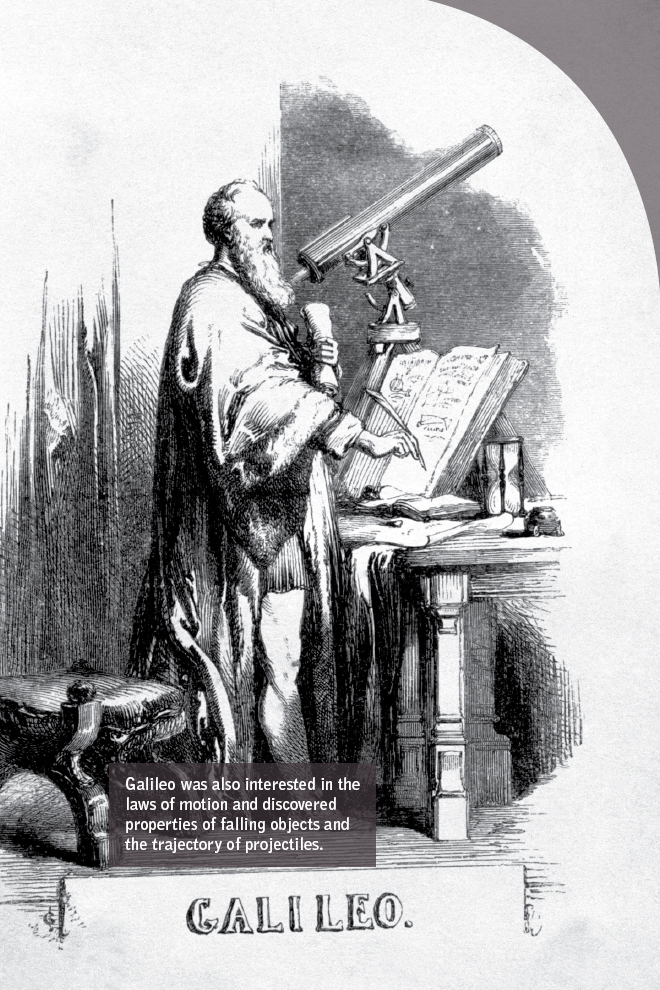

Galileo was also interested in the laws of motion and discovered properties of falling objects and the trajectory of projectiles.
CHAPTER 2
The Science of the Big Bang
Before the Scientific Revolution, there were significant knowledge gaps and technological barriers to understanding the first moments of the universe. Understanding the universe’s early history required telescopes and spectroscopes, among other equipment. It required a nuanced understanding of the properties of light, chemical elements, and atoms. It required a dramatic twentieth-century revision of the scope of the universe.
OPTICS
When you look up at the sky at night with your unaided eye, you can see a beautiful array of stars and constellations. Without a telescope, it’s hard to garner any information from those stars beyond their position in the night sky and their relative brightness. A crucial precursor to the invention of the telescope was the invention of the glass lens within it that created the necessary magnifying effect.
All of these scientific elements came together when Albert Einstein proposed a new theory of gravity that raised curious questions about the future—and past—of the universe.
Lenses
Glass lenses as we know them today were first introduced toward the end of the thirteenth century. Glasswork had long been a tradition in places including Venice and Florence, and by the thirteenth century, craftsmen were producing small disks of glass that could correct the weakening vision of the elderly. The disks were convex on both sides, like a lentil, and were given the name “lentils of glass,” or lenses in Latin. Soon, there were also concave lenses for correcting myopia, or nearsightedness.
The Refracting Telescope
The first telescope was invented in the Netherlands in the early 1600s. In the fall of 1608, two men independently filed patent applications for a telescope design. The first was Hans Lippershey, a German spectacle maker living in Middleburg, the Netherlands. Lippershey had invented a device through which “all things at a very great distance can be seen as if they were nearby.”
A few weeks later, another Dutch spectacle maker, Jacob Metius, filed a patent for a device used for “seeing faraway things as though nearby.” The Dutch States General in The Hague ultimately did not award patents to either of the men as the device was too easy to copy, but both men profited from their designs. Years later, a third Dutch spectacle maker named Zacharias Janssen claimed to have invented the first telescope.
The three Dutch inventors were all craftsmen, not astronomers. It was Galileo, the Italian astronomer, physicist, mathematician, and inventor, who first made the telescope famous.
Without having ever seen a telescope before, Galileo built a telescope in 1609 that used a convex lens at the end (called an objective lens) and a concave lens for the eyepiece. This first telescope made objects appear nine times larger than when viewed with the naked eye.
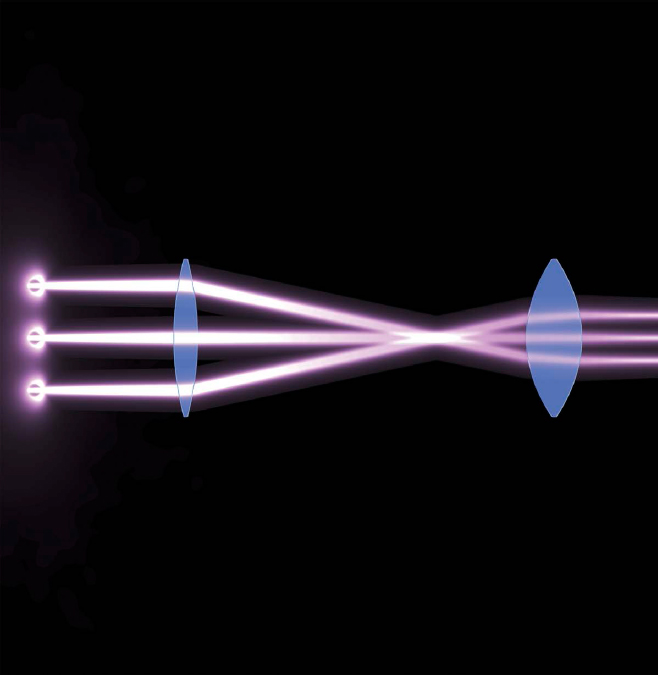
The farther the focal point (where light beams converge) is from a refracting telescope’s objective lens, the greater the magnification.
After improving his telescope design, Galileo made many significant discoveries, including sunspots, four of Jupiter’s moons, and “nebular patches” that he determined were actually regions filled with stars. And yet, the telescope Galileo used for these observations only made objects appear about thirty times closer and had a very small field of view (about a quarter of the full moon could be observed at a time).
These first astronomical telescopes were refracting telescopes, or telescopes that used lenses to bend light. In a refracting telescope, the light from celestial objects first passes through a lens at the end of the telescope, through a focal plane inside the telescope, and then through a second lens (the eyepiece lens) that enables the observer to view the magnified image. A major limitation of refracting telescopes is that different wavelengths of light bend at different angles when they pass through the glass lenses, and the resulting magnified image is slightly distorted. Over the next few centuries, telescope technology advanced significantly.
The Reflecting Telescope
The reflecting telescope, first built in 1668 by the English physicist Sir Isaac Newton, helped remedy the distortion of refracting telescopes. Reflecting telescopes use a concave mirror to reflect light instead of glass lenses that refract light. While different wavelengths of light refract at different angles, they do not disperse at different angles when reflected. Thus, a reflecting telescope has greater focus than a refracting telescope. Reflecting telescopes also don’t require as long of domes as refracting telescopes, which makes them more economical and simple to construct.
Today, most telescopes are reflecting telescopes that use concave mirrors to reflect light. Larger mirrors can gather more light, and mirrors have grown in size over time. Today, the largest telescopes, such as the telescope at the Keck Observatory in Hawaii, use telescopes with multiple mirrors to produce the effect of a larger mirror at a lower cost.
LIGHT
Light permeates and illuminates our daily lives, but it also has the power to reveal vast amounts of information about the cosmos.
Knowing the speed of light, the different types of light, and what light spectra can tell us has been essential to studying the beginnings of the universe.
The Speed of Light
The speed of light is a significant metric in cosmology because when we know how fast light travels, we can use that speed in calculations of how far away different stars, galaxies, nebulae (clouds of gas and dust), and other phenomena are.
Aristotle thought that light traveled instantly, but today we know that light does have a finite speed. The first person to measure the speed of light with relative accuracy was the Danish astronomer Ole Römer in 1676. Römer had studied Jupiter’s moon Io (discovered a half century earlier by Galileo), which is regularly eclipsed by Jupiter as Io moves behind Jupiter in its orbit. Sometimes, the eclipse happened sooner than expected or later than expected.
Römer realized that the early or late appearance of Io from behind Jupiter was due to the varying distance between Earth and Jupiter. When Earth was farther away from Jupiter, the light had to travel farther and thus arrived at Earth later than astronomers had expected. Though Io’s orbit around Jupiter is regular, the timing of the eclipse varied by about an hour throughout the year due to the varying distance between the two planets. Römer estimated that the speed of light was 186,000 miles per second (299,344 km/s), which isn’t far off from its modern-day measurement of 186,282 miles per second (299,792 km/s).
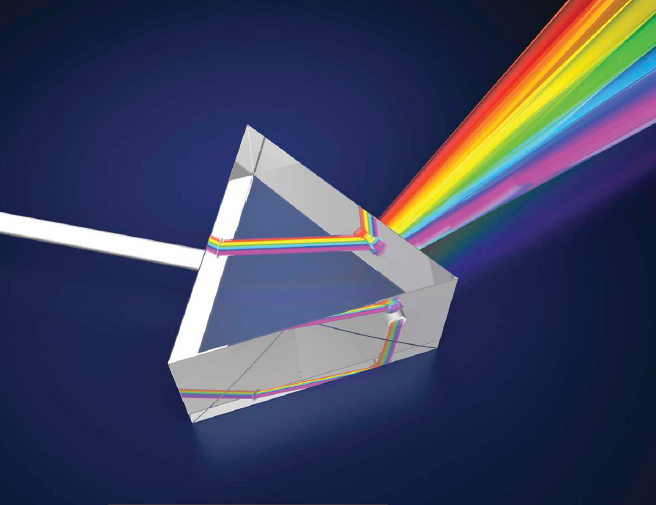
White light is composed of different wavelengths of light that refract at different angles when passing through a prism.
Visible Light Spectra
Another misconception of light was that it was a pure, white substance. As far back as Aristotle, scientists had believed that light creates a rainbow when passed through a prism because the light itself is modified.
In 1665, Isaac Newton proved differently with a simple but convincing experiment. On a sunny day at Cambridge University, Newton darkened his room and made a small hole in the shutter for a beam of light to pass through. Newton placed a glass prism in the beam of light, creating a rainbow or light spectrum.
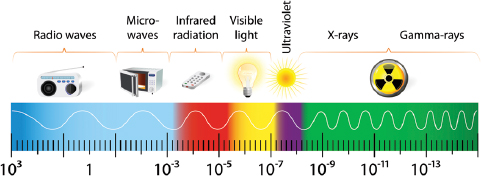
We interact with many portions of the electromagnetic spectrum every day, though we can see only a small portion.
Newton then took a second prism and placed it upside down in front of the first prism. The spectrum of light, with all of its component colors, passed through the second prism and combined back into white light. In this way, Newton showed that white light contains all of the colors of the rainbow.
The Electromagnetic Spectrum
In the nineteenth century, more than a century after Newton discovered the various colors within visible light, scientists discovered that there are many types of light that we cannot see with the naked eye.
In 1800, Sir William Herschel discovered infrared light. Herschel set out to measure the temperature of various colors of light. He used sunlight and a glass prism to create a spectrum of light. He then placed thermometers under each color of light and compared them to a control thermometer. Herschel noticed that the individual colors of light measured higher than the control thermometer and that the temperature increased from the violet to the red end of the spectrum. He then measured the region just beyond the visible red light and found that the temperature here was the highest of all.
Additional experiments showed that this portion of the light spectrum reflected, refracted, absorbed, and transmitted just like visible light did. Today, we use infrared light in police and military surveillance applications, among other uses, as well as to look through interstellar and intergalactic dust to study star formation and the centers of galaxies.
The following year, the scientist Johann Wilhelm Ritter began experiments to find whether invisible light existed on the other end of the spectrum. Ritter used sunlight and a glass prism to create a spectrum. Then, Ritter placed silver chloride, a substance that darkens when exposed to sunlight, in varying colors of the light spectrum. He showed that the silver chloride darkened more on the violet end of the spectrum than on the red end of the spectrum, which was a known phenomenon. Then he placed silver chloride in the area just beyond the violet end of the spectrum and found that the reaction was even stronger. Ritter had discovered ultraviolet light, a type of radiation that we use today for various purposes, from sterilizing medical equipment (and to sanitize pedicure equipment) to studying the composition of stars.
In the late 1880s, the physicist Heinrich Hertz proved the existence of radio waves, which had been theorized by James Maxwell Clerk. Today, we know that visible light, ultraviolet light, infrared light, and radio waves are all part of a larger spectrum called the electromagnetic spectrum.
The electromagnetic spectrum is the range of all types of electromagnetic radiation (energy) from radio waves to visible light to gamma rays and everything in between. We can think of electromagnetic radiation as a stream of massless particles called photons that travel in a wave-like pattern at the speed of light. Each photon contains a different amount of energy. Radio waves are made up of the lowest energy photons while gamma rays are made up of the most energetic photons.
Electromagnetic radiation has energy, wavelength, and frequency. The frequency is the number of cycles per second, or hertz (Hz). The wavelength is the length in meters between two wave peaks. The energy is measured in terms of electron volts (eV). For the purpose of studying the universe and its history, wavelength is the most commonly used measurement. Higher energy regions of the spectrum, such as ultraviolet light, X-rays, and gamma rays, have very small wavelengths. Lower energy regions of the spectrum, such as radio waves, have much longer wavelengths.
Spectroscopy
Every object produces a spectrum that varies in the intensity of its radiation at different wavelengths compared to the spectra of other objects. The type of spectra an object emits depends on both its temperature and its chemical composition.
So far, we have discussed continuous spectra of light, or spectra with a full rainbow of color. There are two other important kinds of spectra that help scientists study stars and galaxies: absorption spectra and emission spectra.
The German physicist Gustav Kirchhoff worked closely with the chemist Robert Bunsen to found the field of spectrum analysis. In the 1850s, the two scientists showed that each element gives off a different color light when heated to incandescence (the point at which an object emits visible light).
When this light is passed through a prism and split into a light spectrum, each element’s resulting spectrum contains a unique pattern of individual wavelengths. Using spectrum analysis, Kirchhoff was able to study the composition of the sun and determine that it contains iron, calcium, magnesium, sodium, nickel, and chromium. (In 1868, Joseph Norman Lockyer used the same technique to determine that the sun contained an unknown element that he named helium after the Greek name for the sun, helios.)
Kirchhoff also discovered that when light passes through a gas, the gas absorbs the same wavelengths of light that it would emit if heated.
Kirchhoff created three laws of spectroscopy that describe absorption and emission spectra:
1.A luminous solid, liquid, or dense gas emits light of all wavelengths.
2.A low density, hot gas viewed against a cooler background emits a bright line or emission line spectrum.
3.A low density, cool gas in front of a hotter source of a continuous spectrum creates a dark line or absorption line spectrum.
When we study a star such as our sun, for example, we study its absorption spectra. The star is a hot source of a continuous spectrum and has a cooler atmosphere of gas that absorbs some of that light. When we study incandescent elements in a lab, we see emission spectra.
Though the structure of the atom was not known at the time Kirchhoff made his laws, we know today that the lines in emission and absorption line spectra are created by electrons absorbing or emitting a specific photon.
An individual atom has a positively charged nucleus with one or more negatively charged electrons in orbit around the nucleus. The orbits represent different potential energies— smaller orbits represent smaller amounts of energy. Electrons can jump between energy levels, always instantaneously, when they gain or lose exactly the right amount of energy to make that leap.
An absorption line is created when an atom is excited (such as by absorbing a photon) and jumps from one energy state to another. For example, if a photon with a specific wavelength (121 nanometers, for example) excites a hydrogen atom in its ground state, that photon will be absorbed. Thus, if we look at a source of continuous radiation through a cloud of hydrogen gas, there will be an absorption line at 121 nm.
When an excited atom returns to its ground state, it will emit a photon of the same amount of energy it once absorbed. In this case, the resulting spectrum shows emission lines that precisely correspond to the element’s absorption lines.
Redshift
Emission and absorption spectra are very useful for understanding the chemical composition of various stars and galaxies. When it comes to measuring the age of the universe, however, it’s even more important to study how the spectral lines of a celestial object have shifted.
When measured in a spectrum, wavelengths of light can shift toward one end of the spectrum or another depending on whether an object is moving toward or away from us. To imagine this phenomenon, consider an ambulance moving toward you. As it first moves closer and then passes you and moves away, its siren seems to change pitch. The siren itself is not changing, however, but the sound wavelengths are compressing and then stretching as it approaches and moves away.
Light waves experience a similar phenomenon. When a celestial object is moving away from Earth, its light wavelengths stretch and elongate, causing the light to appear redder, or redshifted. When a celestial object is moving toward Earth (a relatively rare path), its light wavelengths compress and shorten, causing the light to appear bluer, or blueshifted.
In 1868, William Huggins noticed that the hydrogen spectrum of the star Sirius was slightly shifted. He interpreted this as the effect of Sirius’s radial velocity (movement away) from Earth. Over the next few decades, astronomers began studying the spectra of other stars to determine their radial velocities.
Photons
At the turn of the twentieth century, while studying blackbodies (idealized objects that absorb all incoming radiation) the German physicist Max Planck hypothesized that electromagnetic radiation occurs in discrete bundles of energy called photons.

The very red La Superba (bottom spectrum) contains a large proportion of carbon, and the carbon molecules absorb green, blue, and violet light.
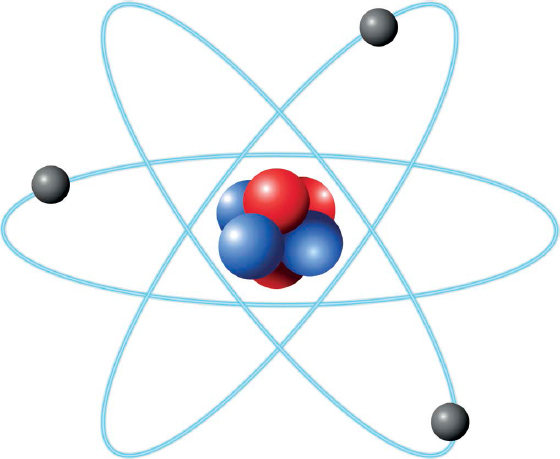
The Bohr model of the atom shows electrons orbiting the nucleus much like the planets orbit the sun.
While much of this book discusses electromagnetic radiation as something that has a wavelength, modern theory holds that light and other particles have characteristics of both waves and particles. As Albert Einstein put it, “We have two contradictory pictures of reality; separately neither of them fully explains the phenomena of light, but together they do.” This phenomenon is called the wave-particle duality.
Knowing that light behaves as a wave but has quanta (discrete amounts) of energy like a particle is especially useful when considering how electromagnetic radiation excites electrons and creates the emission and absorption spectra we learned about in the previous section.
The ATOM
Cosmology and the history of the universe clearly involve the largest known scales of matter and energy, but cosmology also requires an understanding of the very smallest particles as well.
Consider a complex Lego castle set. The Lego box shows an image of the full construction, but to re-create that construction, you must take the individual building blocks and put them together in just the right way. The instructions start with the fundamentals and as you go, the castle looks increasingly like the image on the box.
Reconstructing the history of the universe is something similar, though physicists are still investigating what the very most fundamental building blocks are and how they interact to create the structures and particle interactions we observe today. Particle physics, as this field is called, began with inquiry into the atom.
The atom was first conceived of by the Greek philosopher Demokritos (460 BCE to 370 BCE) as a theoretical unit that makes up all matter and cannot be divided or broken down. In the 1800s, the English chemist John Dalton expanded on this concept and determined that all atoms of a chemical element are identical to one another. In 1897, J. J. Thomson was the first to show that atoms are not the smallest units of matter.
Fourteen years later, in 1911, the Cambridge University physicist Ernest Rutherford discovered the atomic nucleus. Rutherford’s graduate student Ernest Marsden conducted an experiment to see what happens when a stream of alpha particles (positively charged particles) was aimed through a piece of gold foil. Detectors around the gold foil measured the path of the particles. Marsden’s results showed that a small percentage (about 1 in 20,000) of the particles were scattered at angles greater than 90 degrees. The remainder passed straight through or were deflected at lesser angles.
Rutherford concluded from these results that the positive charge and nearly all of the mass of an atom must be concentrated in a very small region of an atom, which explains why only a small fraction of the particles were strongly deflected. (The positive alpha particles were repelled by the concentrated positive regions of the gold atoms.)
In 1920, Rutherford proposed the name “proton” for the positively charged particles in the nucleus. Rutherford suggested that the nucleus also contains a neutral particle, the neutron, which his one-time graduate student and assistant lab director James Chadwick found in 1932. The neutron became very useful for physicists because as a neutral particle, it could be used to smash and break apart other nuclei. (Neutron bombardment was eventually used to split the uranium atom, which led to the development of the first nuclear bomb.)
For a time, physicists thought that the proton, neutron, and electron were the smallest particles in existence. In 1963, however, Murray Gell-Mann proposed that protons and neutrons are made up of even smaller particles called quarks. Other subatomic particles we know today include neutrinos, positrons, muons, and more.
The SCALE of the UNIVERSE
In the beginning of scientific discourse, academics thought that Earth was at the center of the universe. In a paradigm-shifting development that kicked off the Scientific Revolution, scientists eventually accepted that Earth orbits the sun along with other planets in our solar system. Scientists later discovered that we are part of a galaxy called the Milky Way and the sun is actually located quite far from the center. Still, for many years scientists believed that the Milky Way was the only galaxy there was.
Henrietta Swan Leavitt
The relationship between a Cepheid variable star’s period and its luminosity was discovered by the American astronomer Henrietta Swan Leavitt.
Leavitt was born in 1868 in Lancaster, Massachusetts. She attended Oberlin College before transferring and graduating from the Society for the Collegiate Instruction of Women (today Radcliffe College) in 1892. Leavitt began studying astronomy as a senior in college and continued her studies after graduating from college. Unfortunately, she soon suffered a serious illness that left her severely deaf.
Her hearing loss did not get in the way of her love of astronomy, however. Leavitt volunteered as an assistant at the Harvard Observatory in 1895 and in 1902 became a permanent staff member. She quickly rose to become the head of the photographic stellar photometry department.
Leavitt worked on the observatory’s major initiative to determine the brightness of all observable stars. In the course of her work, she invented new methodologies and a standard of photographic measurements that became known as the Harvard Standard. She also discovered more than 2,400 variable stars (about half of the variable stars known at the time).
Most significantly, Leavitt discovered the direct correlation between the length of a Cepheid variable star’s period and the star’s luminosity. Her discovery would be an instrumental part of paradigm-shifting discoveries by astronomers of the time, including Edwin Hubble.
In 1924, a young American astronomer named Edwin Hubble shattered the notion that our galaxy was the only galaxy that existed.
Hubble worked at the Mount Wilson Observatory near Pasadena, California, which had the largest telescope of its time, the Hooker Telescope. He trained the telescope on what was then called the Andromeda Nebula, one of the faint clouds of light that were thought to be nebulae within our own galaxy. (Nebulae, or clouds of gas and dust, do exist throughout the universe, but initially galaxies were mistaken for nebulae within the Milky Way.)
Within the Andromeda Nebula Hubble found numerous stars, including a type of star called a Cepheid variable. Cepheid variable stars pulsate at a rate that directly corresponds to their luminosity (intrinsic brightness). After calculating the luminosity based on how often it pulsates (its period), an astronomer can then determine how far away a Cepheid variable star is. (This type of calculation is much like the mental calculation we perform when we see headlights approaching us at night. We know how bright headlights typically are, and if they look very dim, we know that the car must be far away.)
When Hubble calculated how far away the Andromeda Nebula must be based on the period of the Cepheid variable star, he determined that the Andromeda Nebula was not a star cluster within the Milky Way but a galaxy of its own. Today, we know this “nebula” as the Andromeda galaxy, the nearest major galaxy to the Milky Way.
A NEW GRAVITY
One of the most astounding developments in physics of the twentieth century was Albert Einstein’s general theory of relativity. Published in 1915, the theory presented a geometric theory of gravity that revised the common understanding of gravity based on Isaac Newton’s work centuries earlier.
Newton’s theory of gravity held that gravity is a tugging force between two objects that directly depends on the mass of each object and how far away those two objects are from one another. The moon and Earth both attract one another, for example, but the more massive Earth exerts a relatively stronger attractive force on the moon.
In 1905, Einstein had published his special theory of relativity, which in part stated that space and time are inextricably connected in a four-dimensional continuum called space-time. In his 1915 general theory of relativity, Einstein hypothesized that a massive object will create a distortion in space-time much like a bowling ball distorts the surface of a trampoline.
Just like a marble placed on the trampoline will roll inward toward the bowling ball, objects in space follow the distortions in space-time toward more massive objects. In broader terms, matter tells space-time how to curve, and curved space-time tells matter how to move. Light, too, Einstein predicted, would follow any warps in space-time.
On May 29, 1919, a solar eclipse proved Einstein’s theory of gravity was more accurate than Newton’s. During this particular eclipse, astronomers knew the sun would be passing through the Hyades star cluster. The light from the stars would have to pass through the sun’s gravitational field en route to Earth, and because of the darkness from the eclipse, scientists could observe and measure this light when it arrived.
The English physicist and astronomer Sir Arthur Eddington, leader of the experiment, first measured the true positions of the stars in January and February of 1919. When the solar eclipse happened, he measured the star positions again. The star positions appeared shifted due to the path- altering effect, known as gravitational lensing, of the sun’s gravitational field.
“LIGHT ALL ASKEW IN THE HEAVENS,” the New York Times headline read when the results were announced, accompanied by the following subheading: “Men of Science More or Less Agog Over Results of Eclipse Observations.”
Einstein’s theory of general relativity didn’t just change the way we view gravity. It also created enormous new cosmological questions. Depending on how the equations in his theory were solved, the universe was either expanding or contracting. Einstein preferred to believe it was staying static, so he added a term he called the “cosmological constant” to his equations to force it into stability. He would later come to regret this modification of his otherwise elegant equations.
AN EXPANDING UNIVERSE
The final major scientific discovery that laid the foundation for a history of the universe came in 1929 from Edwin Hubble, again using the Hooker Telescope at the Mount Wilson Observatory.
It was by now known that the universe consisted of numerous galaxies. Many, however, believed that the universe was infinite in time and space. To the contrary, Hubble and his assistant Milton Humason published a paper showing that galaxies were moving away from Earth and that the farther away a galaxy was, the faster it was moving away.
Hubble had again used Cepheid variable stars and other ways of determining distance to plot the distance of each galaxy from Earth. He studied the redshift of each galaxy to plot each galaxy’s radial velocity. The resulting graph was very clear: galaxies are moving away from Earth at a speed directly correlated to their distance from us.
Hubble’s work shattered the notion that the universe existed in some kind of stasis or that it had remained the same size for infinity. It also raised a curious question: If all of the galaxies were moving away from our own galaxy, where had those galaxies been relative to one another in the past?
The answer to that question was the foundation of the big bang theory, the modern standard cosmological model.